CURRENT RESEARCH PROJECTS
Tactile Sensing
This is an important sensing modality for robotic systems,
especially those involved in the grasping, recognition and precise
manipulation of objects. Tactile sensing is not as well developed as
computer vision, in part, because of the lack of suitable sensors. I
have designed a number of highly compliant tactile sensors using the
following principles:
* Nephelometric,
* Fluid resistance (electrical resistance), and
* Strain sensitive rubber.
Giving a tactile sensor a compliant surface enlarges the area
of contact and thus increases the information that can be gathered from
non-planer surfaces. I have also developed tactile sensors to determine
the thermal properties of touched objects and whisker proximity sensors.
The processing of tactile sensory data and sensory control of
robotic mechanisms are other current research topics. Sensory
manipulation and object recognition experiments are performed using the
Monash Dextrous Gripper shown below. The gripper has two
6-degree-of-freedom fingers which are each actuated by a Stewart
platform mechanism. A 6-axis force/torque sensor detects forces acting
on the work-surface and load cells in the root of each finger detect
gripping forces. The fingers also incorporate tactile sensor arrays.
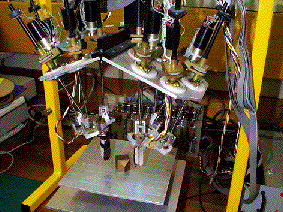
The Monash Dextrous Gripper
Tactile output devices
Shape and force displays provide the natural complement to
tactile sensors and allow tactile information (either real or
synthetic) to be displayed. The following picture shows an 8 by 8 array
shape display. Each of the 64 rods can be set to a height within a 5 cm
range.
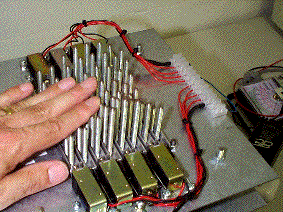
A prototype tactile shape display
Robot
chemical sensing
Quite a number of animals and insects mark their environment
with traces of chemicals. Territorial animals deposit pheromone
markings to indicate the boundaries of their territory and to warn off
competitors. Foraging ants lay trails for worker ants to follow. Having
deposited an odour mark the stored information that it represents is
available to be read at a later time by the creature that made the
marking or by others of the same species. These markings can be used as
an aid to navigation or to help coordinate the actions of a group of
creatures. To perform useful tasks in an unconstrained environment
mobile robots have to solve similar navigational and organisational
problems to those that challenge insects and other simple creatures. I
have called any method of storing information in the environment in a
form that dissipates over time a short-lived navigational marker. The
following picture shows a miniature robot equipped to detect odour
marking on the ground.
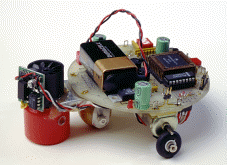
Miniature robot equipped to follow chemical trail trails on
the ground
Many of the potential applications for chemical sensing robots
involve locating the source of a chemical plume released into the air.
With this kind of capability a mobile robot could perform some of the
tasks that we currently assign to sniffer dogs including the detection
of::
o plant matter, drugs and other materials important to the
customs service,
o truffles,
o victims of avalanches and earthquakes,
o escaped prisoners,
o chemical leaks, and
o mines and unexploded bombs.
In most cases vast improvements will be required in chemical
sensing technologies before robots can perform these tasks. However,
even without improved sensors it is still possible to make progess in
areas such as robot design and control algorithms.
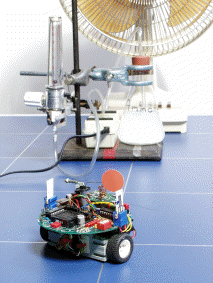
A robot equipped with two conducive polymer chemical
sensors
and a wind vane
locates the source of a plume of ammonia
Robot learning
Robot learning is a very appealing area of research that has a
number of potential benefits. A robot with the ability to learn would
require less application-specific programming to customise it for
performing a particular operation. If the environment changed then a
learning robot may also be able to adapt appropriately without external
guidance.
For me this is a new area of research and so there are no
publications as yet. The current project focuses on the transition
between an organism whose genetically evolved competence is purely
inherited and one with the added ability to learn from its environment.
The framework of the project draws on Rolf Pfeifer's ideas about
building complete autonomous systems that he calls "Fungus Eaters". For
this project a self-contained environment EDEN has been constructed to
act as an ecological niche for a mobile robot (ADAM Robot). It is
anticipated that the robot will be able to improve its performance by
learning from its interactions with this environment. See below for a
QuickTime video clip.
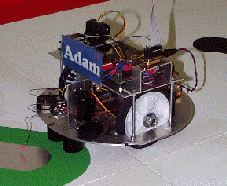
ADAM Robot feeds from a 'flower' in EDEN
Other topics
In order to build the robotic platforms necessary to try out
new robotic sensors I also maintain an interest in robotic mechanisms
and novel robotic actuators such as shape-memory alloy,
electrorheological fluid clutches, magnetic fluids, etc.
Some Media Coverage
Chemical sensing
http://www.theage.com.au/articles/2003/09/10/1062902115129.html?from=storyrhs
http://www.wired.com/wired/archive/12.07/race_pr.html
http://www.abc.net.au/ra/innovations/stories/s990572.htm
http://www.guardian.co.uk/life/feature/story/0,13026,1358531,00.html
Robot Learning
http://radio.weblogs.com/0105910/2003/08/20.html
The following video clips show some recent
experiments.
LEGO robot hockey preliminary 2002 (4.9MB)
ADAM Robot learns to avoid bumping into
a wall (1.4MB)
ADAM Robot in EDEN (a longer version of
the previous clip) 2.8MB)
Robot following a chemical trail
(1,4MB)
Robot locating the source of a
chemical plume (1.1MB)
Same as the previous clip
(better quality for people prepared to wait longer - 3.1MB)
A tennis ball collecting robot
(2.3MB)
The tennis ball collecting robot was built by a final year
thesis project student based on a robot seen in the labs of Prof.
Masayuki Inaba at the University of Tokyo.
|